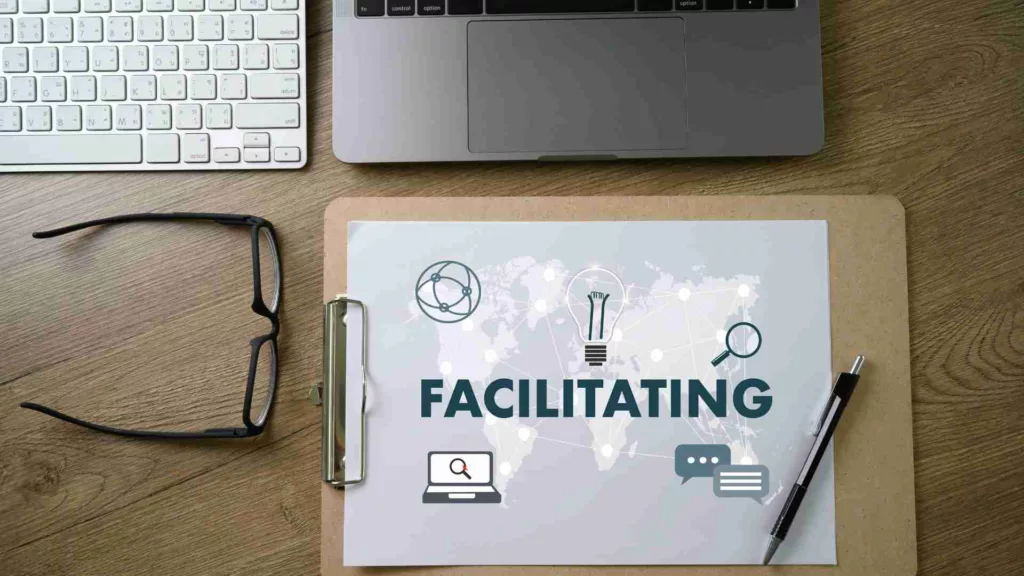Posted in Blog, Facilitation, Self confidence, Virtual Facilitation by Jo North
Turning Criticism into Growth: A Guide to Handling Negative Feedback about Your Facilitation
Receiving negative feedback about your facilitation can be a tough pill to swallow. However, it’s important to remember that criticism is not always a bad thing. In fact, it can be a catalyst for growth and improvement.
As a facilitator, you’ll also face the challenge of receiving a lot of feedback! It could be that there’s feedback of some kind on every design sprint, workshop or training session that you run. That’s a huge amount of diverse perspectives to deal with.

This guide will provide you with valuable insights on how to handle negative feedback about your facilitation, and turn it into an opportunity for personal and professional development.
I’ll give you some effective strategies for receiving criticism with grace, analyzing it objectively, and using it as a stepping stone towards becoming a more skilled and confident facilitator.
I’ll also share some tips and support for dealing with feedback that feels personal rather than constructive. Plus, what to do when the sheer volume and frequency of feedback that you’re getting is overwhelming.
Whether you’re new to facilitation or a seasoned pro, this guide will equip you with the tools you need to transform negative feedback into a powerful tool for growth. It will also help you to look after your mental health, wellbeing and energy. I hope you find it really helpful.

My Own Experience of Receiving Feedback on My Facilitation
Before we dive in, I’d like to provide some context regarding my personal experiences with receiving feedback on my facilitation.
My journey in facilitation spans more than a decade, during which I’ve had the opportunity to engage with thousands of individuals across the globe. My work involves facilitating both in-person and online sessions on a regular basis.
Scarcely does a session conclude without some form of feedback. I’ll often build a feedback activity into the end of the workshop. Also, as part of the organization’s standard procedures, the client typically circulates a feedback survey to participants post-session. There are occasions when I can help to shape the questionnaire, but not always.
To be candid, I maintain a rather neutral stance on feedback. I diligently review all of it with a growth mindset, absorbing the information for continuous learning and improvement.
Workshop Success is a Collaborative Endeavor
However, I also think that the success of training sessions, sprints, and workshops is not solely on my shoulders. Success (or otherwise) is the result of a communal, cooperative endeavor.
Participants have a degree of responsibility to approach the event with an open mind, intent on capitalizing on the experience and contributing to the best of their ability that day. This is particularly important when the participant’s attendance isn’t voluntary or when they just don’t want to be there.
After all, we are professionals at our workplaces. My perspective is that if you have to do something, you should strive to make the most of it. The time spent is irreplaceable. Moreover, it doesn’t seem productive or fair to negatively impact the experience or outcomes for others.
Asking for Feedback
In the discussion about feedback in my free, private Idea Time for Workshop Facilitators Facebook group, Emma, one of my brilliant community members said:
“I think part of the problem is you are asked for feedback about everything now, every product, my weekly supermarket delivery etc, I think we all might be feedbacked out? If that’s even a term! I tend to find people want to get away at the end of a long day, and if you ask them to do feedback it’s not always that useful or detailed.
It can be beneficial to finish a bit early to give plenty of time for it, or send an online form as a follow up the next day. The next day you get better quality responses but not everyone replies. It’s a tough one! As we all need feedback to develop and grow as individuals and facilitators.”
I agree with Emma. It’s important to build in feedback completion time at the end of the session if possible. Keep the number of questions to a minimum and focus on the most important things. You can also build in a breakout group activity designed for feedback purposes, rather than just going down the traditional questionnaire route.
Being considerate about how and when you ask your workshop feedback participants to feedback will help you to get a more balanced set of results.
Context
I am fortunate that the vast majority (over 95%) of feedback I receive is insightful, beneficial, and balanced. On extremely rare occasions, feedback from a few individuals may be influenced by external issues, be overly personal to be of any constructive use, or may stem from other agendas. When this has happened, my clients have been astute enough to identify and flag them. I am deeply grateful to work with such fantastic customers who are fair-minded, practical, and supportive.
In addition, I am not facilitating all the time. My work usually involves other activities such as coaching, keynote speaking, strategy development and innovation consulting.
All that said, if we facilitate enough people over a long enough period of time, receiving some negative feedback at some point is inevitable. The important thing is to focus on not taking it personally, and understanding that no-one can please all the people, all the time.
Maintaining Mental Health and Wellbeing as a Facilitator
Maintaining mental health and wellbeing as a facilitator, particularly when receiving a constant stream of feedback—both positive and negative—is essential.
Balancing your response to praise and criticism, while still preserving a healthy mental state, requires a combination of emotional resilience, self-awareness, and self-care strategies.

Emotional Resilience
Emotional resilience is the ability to bounce back from adversity. In this case, it’s negative feedback. You can build emotional resilience through practices like mindfulness, which encourages staying present and accepting experiences without judgment.
You can also use cognitive behavioral techniques to help reframe negative thoughts and promote a more positive outlook.
Self-awareness
Being aware of your emotions and reactions is key to maintaining mental health. This helps you identify when you’re feeling stressed or overwhelmed and enables you to take necessary steps to manage these feelings. Regularly check in with yourself, note how you’re feeling, and acknowledge your emotions without judgment.
Balanced Perspective
Keep in mind that feedback, positive or negative, is not a definitive assessment of your worth or abilities, but rather insights aimed at improvement. It’s important to maintain perspective and not let any single piece of feedback disproportionately impact your self-perception.
Healthy Boundaries
Establishing healthy boundaries is essential. It can be as simple as allocating specific times of the day to read and process feedback. Avoiding absorbing feedback first thing in the morning or last thing before bed. This can help manage anxiety levels and improve sleep quality.
Self-Care
Regular exercise, healthy eating habits, and enough sleep are fundamental elements of self-care and play a significant role in managing stress levels. Mind-body practices such as yoga, meditation, or even simple deep-breathing exercises can also promote relaxation and enhance your overall mental well-being.
Support Network
Having a support network to share your feelings and experiences can be immensely helpful. This could be family, friends, or colleagues who understand your role’s challenges and can provide empathy and encouragement. If you’d like to be part of a community of supportive, like-minded facilitators, come and join my free, private Facebook Group – Idea Time for Workshop Facilitators.
Professional Help
If you find your mental health persistently affected despite your efforts, don’t hesitate to seek professional help. A trained therapist or counselor can provide effective coping strategies and cognitive behavioral therapies to manage stress and improve mental health.
Continual Learning and Growth
Embrace a growth mindset. View each feedback as a stepping stone towards betterment. Celebrate your improvements and forgive your mistakes—remember, learning is a continuous process.
Positive Affirmations
Regularly remind yourself of your skills, capabilities, and past successes. Positive affirmations help boost self-confidence and mitigate the impact of negative feedback.
Mindful Reflection
Set aside some time each day to reflect on your achievements and the positive aspects of your day. This practice helps shift focus from negatives to positives and cultivates gratitude.
Remember, everyone’s journey is unique, and what works best for one person may not work as well for another. The key is to find strategies that work for you and incorporate them into your routine. Feedback is an integral part of growth as a facilitator, but it’s equally essential to prioritize your mental health and wellbeing along the way.

Understanding the Importance of Feedback in Facilitation
Feedback is an essential component of facilitation. It provides valuable insights into our strengths and weaknesses, helping us identify areas for improvement. Negative feedback, in particular, can be a powerful catalyst for growth. It challenges us to reassess our approach, question our assumptions, and learn from our mistakes. By embracing negative feedback, as facilitators we can foster personal and professional development, ultimately becoming more effective in our roles.
Types of Negative Feedback in Facilitation
In any type of facilitation, be it workshops, training sessions, seminars, or meetings, negative feedback is almost inevitable. Whether it’s a participant pointing out an overlooked detail or expressing dissatisfaction with a process, negative feedback comes in a wide range of forms. Understanding and interpreting these various forms of feedback is crucial to the improvement and success of future facilitation.
Direct Negative Feedback
Direct negative feedback is often the most recognizable. This includes pointed critical comments, harsh evaluations, or participants openly expressing dissatisfaction.
It can be as simple as a participant saying, “I didn’t understand that point,” to more complex evaluations such as, “I think the pace of this session was too fast and lacked focus.” This type of feedback, while occasionally harsh, provides an explicit understanding of what needs to be improved upon, and can be a gold mine for facilitators seeking to refine their approach.
Indirect Negative Feedback
Indirect negative feedback, on the other hand, can be much harder to spot, but is equally important. This often comes in the form of nonverbal cues and body language. For instance, participants looking at their watches, using their phones, or displaying signs of disinterest or boredom, such as yawning or losing focus. While these actions are not verbal criticisms, they signal a lack of engagement or dissatisfaction that the facilitator needs to address.
Explicit Negative Feedback
Explicit negative feedback refers to straightforward, specific suggestions or criticisms meant to improve the facilitation process. These are clear-cut, leaving little room for misinterpretation. For example, a participant might suggest, “You should provide more real-life examples,” or “I think you should allocate more time for group discussions.” This feedback is beneficial in that it gives a clear roadmap for future improvements.
Implicit Negative Feedback
Implicit negative feedback is somewhat trickier to navigate. It leaves the facilitator with the task of deciphering the underlying message. This could be a participant vaguely stating, “I just didn’t find the session engaging,” without offering specifics, or subtly alluding to issues without directly stating the problem. This type of feedback requires careful attention and analysis to fully understand and act upon.
Whether it’s direct, indirect, explicit, or implicit, negative feedback offers invaluable insights into where facilitation can be improved. Recognizing and understanding these different forms of feedback is a crucial step towards making constructive changes, enhancing your facilitation skills, and, ultimately, delivering more successful and engaging sessions.

The Impact of Negative Feedback on Facilitators
The experience of receiving negative feedback can significantly influence facilitators in myriad ways. It’s an inherently human response to feel defensive or disheartened when faced with criticism, especially when you’ve put substantial effort and passion into your work. These emotional reactions are entirely normal, yet it’s crucial not to let them cloud your perspective.
To begin with, it’s vital to realize that negative feedback is neither a personal attack, nor a reflection of your inherent worth or ability as a facilitator. Indeed, the feedback is more a reflection of the experience or understanding of the participant providing the feedback, as well as their expectations and preferences, which might differ from yours. It is not a determinative judgement of your competence or expertise, but rather a singular perspective informed by their personal context.
Feedback as a Resource
Consider this: Feedback, negative or positive, is a tool for growth and advancement. It provides a window into how others perceive your work, offering insights that you may have missed or perspectives that you hadn’t considered. When viewed through this lens, negative feedback transforms from a source of discomfort to an invaluable resource for self-improvement.
To facilitate this transformation, reframing your mindset is paramount. Instead of viewing feedback as a critique or failure, you can perceive it as a springboard for development and a catalyst for change. This shift in perspective can help reduce the initial emotional impact, and even infuse the process with a sense of optimism and eagerness for improvement.
All Feedback is Data
Further, it is worth noting that all feedback, regardless of its nature, is data.
Negative feedback reveals areas of discrepancy between your intended output and the input received by the audience. It illuminates the areas where your methods might not resonate with every participant. Recognizing this helps you to tailor your approach to a wider range of learning styles and preferences, thereby enhancing your effectiveness as a facilitator.
By embracing negative feedback and using it to your advantage, you can foster your growth mindset. This approach not only advances your facilitation skills, but also contributes to your personal growth, strengthening your resilience and adaptability.
Negative feedback, when approached with the right mindset, can become a powerful tool for change and progress.

But what if the feedback isn’t fair?
Dealing with feedback that feels unjust, or that is personal and unkind, can indeed pose a significant challenge. These situations require particular care and a balanced perspective. It’s important to remember that not all feedback will be constructive or fair. At times, it may be more a reflection of the individual providing the feedback than of your facilitation abilities.
When confronted with feedback that doesn’t seem fair, it’s essential to take a step back and analyze it objectively. Ask yourself, is there any truth or valuable insight in this feedback? Sometimes, even when feedback appears to be unfair on the surface, it may still contain an element of truth that can be beneficial for your growth. If after careful consideration you find that the feedback lacks validity and seems more rooted in a misunderstanding or bias, acknowledge it. But, don’t let it influence your self-esteem or your approach to facilitation.
What if the feedback is personal and unkind, rather than helpful?
In cases where feedback is personal and unkind, it’s essential to maintain professionalism. Feedback should always be about the behavior or output, and not about the person. If it crosses this line, it’s crucial to address it directly but tactfully. You might respond by saying, “I appreciate your input, but I would like to keep our discussion focused on the content and the process, rather than personal attributes.” Establishing this boundary can discourage personal attacks in the future, and maintain a respectful and constructive environment.
How You Respond to Feedback is Up to You
Remember, it’s okay to reject feedback that is blatantly unfair or unnecessarily hurtful. You don’t have to internalize every piece of feedback you receive. It’s essential to filter through and separate the feedback that aids your development from the feedback that could potentially derail your growth.
Seek Feedback from Multiple Sources
It’s also a good idea to seek feedback from multiple sources to get a more balanced view of your facilitation skills. This approach will allow you to see if the criticism is an isolated incident or if it’s something that others also observe. It can provide a more comprehensive and fair picture of your performance.
Keep Feedback in Perspective
The key in these challenging scenarios is to maintain your self-confidence and resilience. Remember your strengths, accomplishments, and the positive feedback you have received. Don’t let unjust or unkind feedback overshadow the positive aspects of your work. It’s crucial to keep these experiences in perspective and not let them define your worth or capabilities as a facilitator. Feedback, both positive and negative, is just one part of your journey to becoming a more effective facilitator.
Shifting Perspectives: Seeing Negative Feedback as an Opportunity for Growth
To effectively handle negative feedback, it is crucial to shift our perspective and view it as an opportunity for growth. Rather than seeing criticism as a personal attack, we can reframe it as valuable input that can help us become better facilitators. By embracing this mindset, we can approach feedback with an open mind, actively seeking insights and areas for improvement.
Steps to Effectively Handle Negative Feedback in Facilitation
Handling negative feedback requires a thoughtful and deliberate approach. Here are some steps to help you navigate and make the most of criticism:
1. Listen or Read with an Open Mind
When receiving negative feedback, actively listen or read without becoming defensive. If face-to-face, create a safe space for the person providing feedback to express their thoughts and concerns.
2. Analyze Objectively
Take a step back and analyze the feedback objectively. Separate the content of the criticism from the delivery, and focus on the underlying message. Look for patterns or recurring themes to identify areas for improvement.
3. Reflect and Self-Assess
Engage in self-reflection to understand your own perspective and biases. Be honest with yourself and acknowledge areas where you may have room for growth. Use the feedback as an opportunity to assess your facilitation skills and identify areas for improvement.
4. Seek Clarification
If the feedback is unclear or ambiguous, don’t hesitate to seek clarification. Ask questions to gain a deeper understanding of the specific issues raised. This will help you address the feedback more effectively.
5. Learn and Adapt
Once you have analyzed the feedback, take actionable steps to address the identified areas for improvement. Seek out resources, training, or mentorship opportunities that can help you grow as a facilitator. Implement what you have learned and adapt your approach accordingly.

Responding to Negative Feedback Professionally and Constructively
Responding to negative feedback requires professionalism and constructive communication. Here are some guidelines to help you respond effectively:
1. Express Gratitude
Begin by expressing gratitude for the feedback. Acknowledge the time and effort the person has taken to provide their insights.
2. Remain Professional
Respond to negative feedback in a professional and composed manner. Avoid becoming defensive or argumentative. Instead, focus on understanding the concerns and seeking solutions.
3. Offer Solutions
Propose solutions or actions you plan to take to address the feedback. Demonstrate your commitment to growth and improvement by outlining concrete steps you intend to take.
4. Follow Up
Follow up with the person providing the feedback to keep them informed of your progress. This demonstrates your dedication to improving your facilitation skills and reinforces a culture of open communication.
Embracing Feedback for Continuous Growth in Facilitation
In conclusion, negative feedback can be a powerful catalyst for growth and improvement in facilitation. By understanding the importance of feedback, shifting your perspective, and adopting effective strategies for handling criticism, you can transform negative feedback into a valuable tool for personal and professional development.
Through creating a safe and open feedback ethos, actively seeking and processing feedback, and incorporating it into your development plans, you can become an even more skilled and confident facilitator.
If you’d like some help with your facilitation, head over to my free downloadable resources here for you now. If you’d like some one-to-one facilitation coaching, please get in touch and book a one-to-one session with me.

